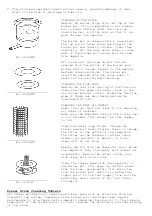
the regulator can discharge approx. 1/2 litre over a period of 10 hours due to
the violent motion of the float and float chamber. But only in heavy weather.
The overflow is also an important safety precaution. If the regulator float or
valve mechanism should fail, the fuel oil will run through into the waste oil
tank, and not into the stove, which could cause overheating, excessive oil use
and possibly cause fire.
We at the factory have often received regulators for reconditioning where the
overflow outlet has been blanked off.
We strongly advise against this practice.
By mounting the overflow pipe, you must hold reverse on the nut to prevent too
much force and break the nipple. (The nipple can be replaced).
The regulator is very sensitive to dirt and water in the fuel supply. It is very
important to clean the filter in the bottom of the regulator once every month.
The maximum and minimum supply capacity is noted on the oil control in cc/min.
The max. and min. for the various model of stove are as follows:
Model 62, 66, 71 and 70 = 2,0 - 6 cc/min.
Model 60, 61 and 64 = 3,0 - 14 cc/min.
Model 67 MS = 5,0 - 17 cc/min.
Model 67 MV = 5,0 - 20 cc/min.
Model 2000K and 2000KV = 3,5 - 9 cc/min.
All regulators are set by the factory for diesel oil with an oil viscosity of 4,0
at a temperature of 20 degrees centigrade. Diesel oil evaporates at approx. 77
degrees centigrade and becomes “waxy” at approx.
-10 degrees centigrade which can cause the stove to extinguish.
The stove can also burn paraffin which is a cleaner and more fluid fuel. The
regulator would need to be adjusted.
11. CLEANING PIN
The cleaning pin is made of 6 mm dia. stainless steel, which slides in a brass T-
piece, through a rubber O-ring, which can be changed in the event of leakage.
The cleaning pin is used to keep the fuel supply to the burner free from the
products from combustion (soot etc.). Under constant use the cleaning pin should
be pushed in and out a few times every 14 days to keep the fuel inlet free from
obstruction.
It is important that the cleaning pin is not left pushed right in whilst the
stove is in use, as in this position the end of the pin extends into the
combustion chamber and the end of the pin can be coated in soot and slag thus
Paraffin first becomes “waxy” at -35
degrees centigrade. Thus it can be a good
idea to mix paraffin with diesel oil, with
very low temperatures, in a rate of 1:1.
There are also several brands of diesel
oil additive which can prevent problems
because of frost.
Summary of Contents for 2000K
Page 1: ...Tel 49 0 40 8890100 www toplicht de Schiffsausr ster...
Page 3: ......






























